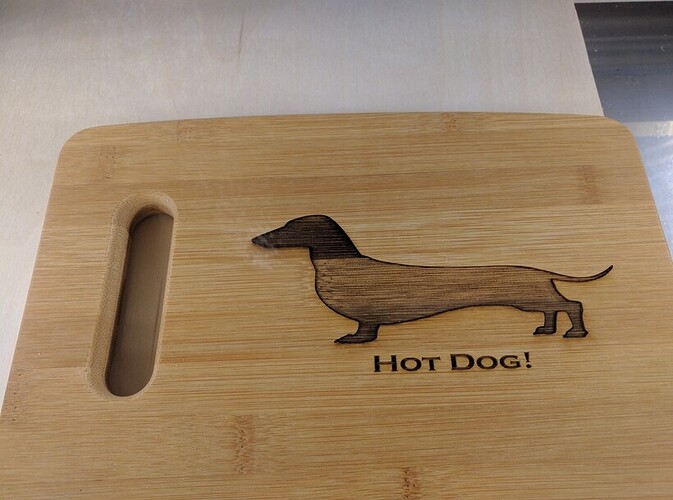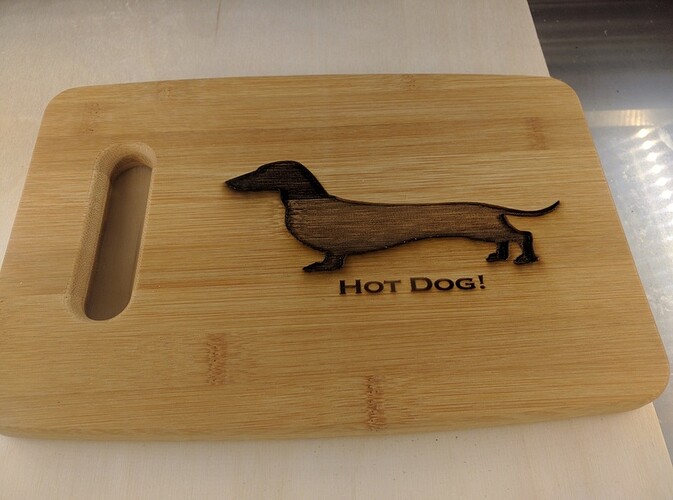Okay, not a real squirrel. Just the metaphorical kind. The kind that distracts you from something you intended to do but diverts you by running past. This forum (& not to mention your correspondent) is disproportionately populated by squirrel chasers.
Here’s tonight’s chase. I’ve been offline for almost two weeks traveling for work (with a side trip to WV to smoke 150lbs of brisket and baby backs for about 80 of my motorcycle compatriots riding a scavenger hunt type rally last weekend). Before I left I was finishing another little project (physics coasters) and one for my wife in the form of a garden lantern. Tonight I was determined to finish them.
Hah!
That was before @dan_berry threw down a gauntlet of sorts this afternoon in a discussion about the Muse owner whose machine has been repeatedly bricked by FSL but was finally up and running today when he posted a video of a cutting board he was making. The short of it is we disagreed about the effect engraving a dachshund (a picture of one, we weren’t arguing the merits of squeezing a little doggie into the Glowforge for a unique tattoo ![]() ) in various orientations vs the grain of a bamboo cutting board.
) in various orientations vs the grain of a bamboo cutting board.
Of course the chase was facilitated by me having one of those days at work where anything but work is interesting.
Arriving at home I pulled out a blank bamboo cutting board (I have dozens - they’re great for quick custom projects when you don’t know what else to bring someone for a hostess party gift). Fired up Inkscape and genned up a quick dachshund silhouette engraving.
My theory is that for a monolithic design like a dachshund (vs a complex one of a tree for instance) where there is a large engraved area that has pronounced height vs width differentials it’s faster to engrave it with the long dimension parallel to the gantry (across the width of the Glowforge). Further, the common wisdom of engraving across the grain of tight grained woods like bamboo does not result in an appreciably more aesthetically pleasing finish - especially not in light of the speed difference.
The net speed of an engrave is related to the operation speed (travel) you specify when telling the laser what you want it to do. But it can be inordinately affected by the number of times the head has to change directions as it makes passes back & forth. The slowing & speeding back up can consume as much or even more time than the actual engraving path in my experience. This is often seen with narrow long engraves.
Like a dachshund.
If the dachshund is horizontal to the front of the laser each pass goes a long way before reversing direction. If the dachshund is rotated 90 degrees so he’s butt down, nose up, there are going to be many, many more direction changes because each pass is much shorter than the horizontal dachshund. The dog is a perfect example of this phenomenon because they are 2 or 3 times as long as they are tall.
With the design done here’s the project ready for the Glowforge.
Notice the cutting board is sitting on a stack of plywood. That’s because my board was 0.600 inches thick. Not fitting in the focus range of the GF with the tray installed. The stack of plywood lets me get the board in focus range.
With the design loaded (I told the GFUI it was 1/8" maple hardwood so I could see what its settings might be as a starter).
I set the engrave for 1%/335/270LPI and the score around the outside of the dog at 50%/100.
Engraves at 270LPI usually give pretty decent results without taking forever. Here’s the GF estimate:
Just short of 9 minutes later this is what it looks like:
A second pass at 340LPI is projected to take 11 minutes and results in this:
A little closer:
The second higher res pass didn’t do anything to reduce the grain lines but did dig it deeper.
Now to the challenge. Will spinning the dog on its tail and engraving across the grain take longer (no doubt in my mind at all) and will the engrave be “nicer” looking?
Same settings as the 8:56 horizontal version first attempt gives us this when the dog is vertical so the engrave goes across the grain:
Now 15:22 isn’t twice as long as the first run, but close enough for hand grenades & nuclear bombs.
Was it oh so aesthetically more pleasing?
Eh? Metzhe metzhe. I didn’t run it again at 340LPI because I didn’t see any appreciable “wow!” quality difference in the lower res. Certainly not enough to burn another 15 life minutes. If you’d argue that it’s nicer, is it twice as nice? If you’re running a business you’d get nearly 2 of the first one out in the time it takes to do one across the grain.
You can be the judge, but I think this squirrel has been run to ground. Back to physics. I’ll post that report tomorrow.










